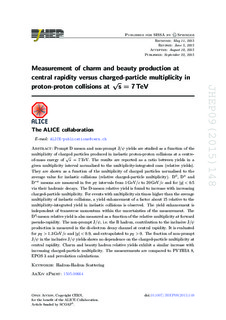Measurement of charm and beauty production at central rapidity versus charged-particle multiplicity in proton-proton collisions at √s = 7 TeV
Adam, Jaroslav; Adamová, Dagmar; Aggarwal, Madan M.; Aglieri Rinella, Gianluca; Agnello, Michelangelo; Agrawal, Nikita; Ahammed, Zubayer; Ahmed, Ijaz; Ahn, Sang Un; Aimo, Ilaria; Alme, Johan; Helstrup, Håvard; Hetland, Kristin Fanebust; Kileng, Bjarte; Altinpinar, Sedat; Djuvsland, Øystein; Haaland, Øystein Senneset; Huang, Meidana; Lønne, Per-Ivar; Nystrand, Joakim; Rehman, Attiq ur; Røhrich, Dieter; Ullaland, Kjetil; Velure, Arild; Wagner, Boris; Zhang, Haitao; Zhou, Zhuo; Zhu, Hongsheng; Arsene, Ionut Christian; Bätzing, Paul Christoph; Dordic, Olja; Lindal, Svein; Mahmood, Sohail Musa; Milosevic, Jovan; Qvigstad, Henrik; Richter, Matthias; Røed, Ketil; Skaali, Toralf Bernhard; Tveter, Trine Spedstad; Wikne, Jon Christopher; Zhao, Chengxin; Langøy, Rune; Lien, Jørgen; Aiola, Salvatore; Ajaz, Muhammad; Akindinov, Alexander; Alam, Sk Noor; Aleksandrov, Dimitry; Alessandro, Bruno; ALICE, Collaboration
Journal article, Peer reviewed
Published version
Permanent lenke
http://hdl.handle.net/11250/2489065Utgivelsesdato
2015Metadata
Vis full innførselSamlinger
- Institutt for mikrosystemer [546]
- Publikasjoner fra CRIStin [3623]
Sammendrag
Prompt D meson and non-prompt J/ yields are studied as a function of the multiplicity of charged particles produced in inelastic proton-proton collisions at a centreof-mass energy of p s = 7TeV. The results are reported as a ratio between yields in a given multiplicity interval normalised to the multiplicity-integrated ones (relative yields). They are shown as a function of the multiplicity of charged particles normalised to the average value for inelastic collisions (relative charged-particle multiplicity). D0, D+ and D + mesons are measured in five pT intervals from 1 GeV/c to 20 GeV/c and for |y| < 0.5 via their hadronic decays. The D-meson relative yield is found to increase with increasing charged-particle multiplicity. For events with multiplicity six times higher than the average multiplicity of inelastic collisions, a yield enhancement of a factor about 15 relative to the multiplicity-integrated yield in inelastic collisions is observed. The yield enhancement is independent of transverse momentum within the uncertainties of the measurement. The D0-meson relative yield is also measured as a function of the relative multiplicity at forward pseudo-rapidity. The non-prompt J/ , i.e. the B hadron, contribution to the inclusive J/production is measured in the di-electron decay channel at central rapidity. It is evaluated for pT > 1.3 GeV/c and |y| < 0.9, and extrapolated to pT > 0. The fraction of non-prompt J/ in the inclusive J/ yields shows no dependence on the charged-particle multiplicity at central rapidity. Charm and beauty hadron relative yields exhibit a similar increase with increasing charged-particle multiplicity. The measurements are compared to PYTHIA 8, EPOS 3 and percolation calculations.
